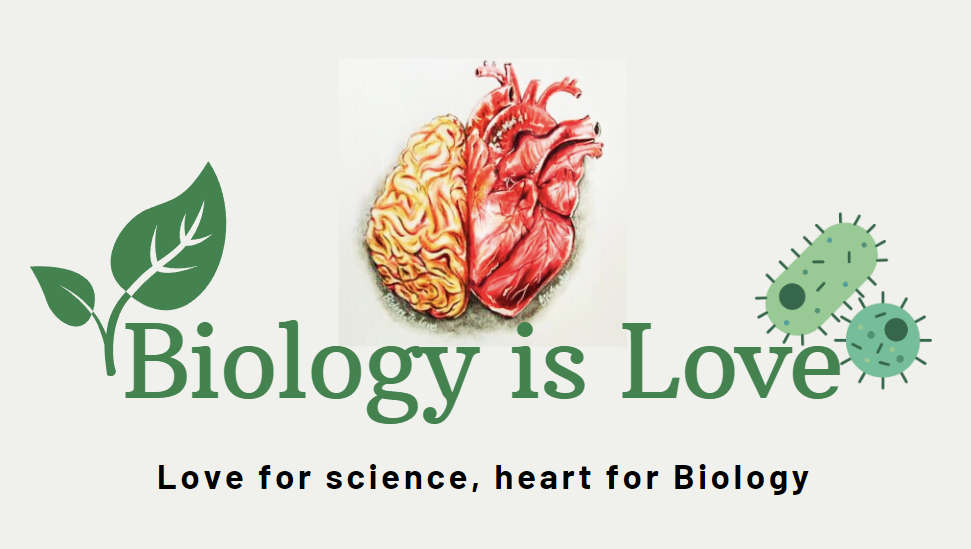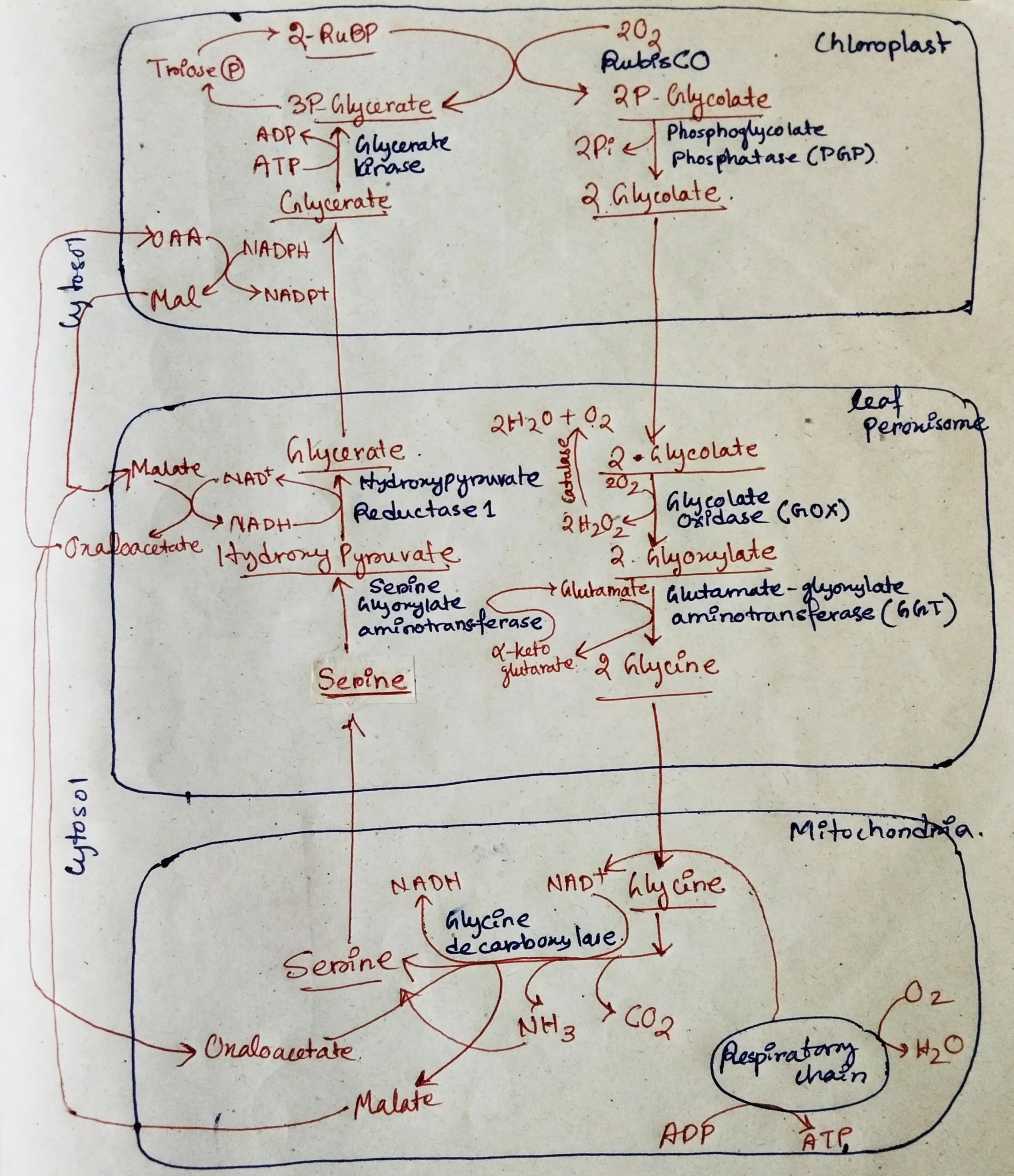Table of Contents
Photorespiration is termed as the respiration that occurs in green cells in the presence of light resulting in excess of CO2 formation.
Inventor of Photorespiration
Decker and Too (1959) first observed the process and found that the rate of respiration in green leaves of some plants is much more in light than in the dark.
Introduction
In this process, the first product is the 2-C compound phosphoglycolic acid, therefore this process is also called C2 pathway. The process occurs in a series of cyclic reactions which is also called Photosynthetic carbon oxidation or PCO cycle.
Occurrence
This process generally occurs in temperate plants, such as beet, bean, cotton, rice, wheat, barley, etc.
Schematic representation of photorespiration in an easy way for initial understanding:
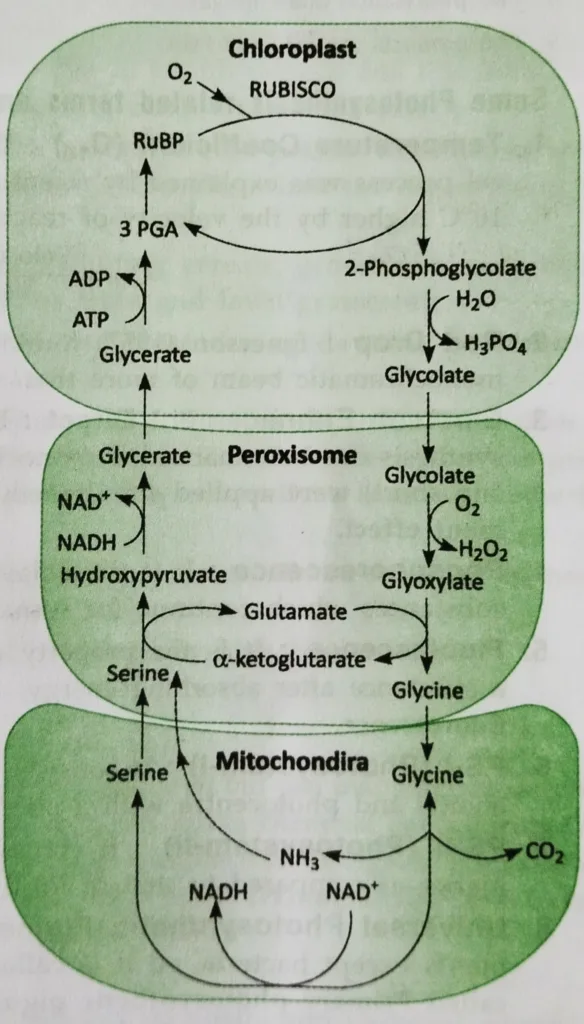
Mechanism:
- In chloroplast, with the increase in O2 concentration and rise in temperature RuBP carboxylase-oxygenase (Rubisco) catalyzes the conversion of the RuBP to 3-Carbon compound, 3-phosphoglyceric acid (PGA) and a 2-carbon compound 2-phosphoglycolic acid.
- RuBP + O2 ——-RuBP oxygenase——> 3-Phosphoglyceric acid (PGA) + 2-phosphoglycolic acid.
- 2-phosphoglycolic acid quickly converts into glycolic acid by the enzyme of phosphoglycolate phosphatase.
- Phosphoglycolic acid——Phosphoglycolate Phosphatase+ H2O——-> Glycolic acid + H3PO4
- From chloroplasts, PGA enters into the Calvin cycle while glycolate migrates into the peroxisome. In peroxisome, it is oxidized to glyoxylate in the presence of the enzyme glycolic acid oxidase.
- Glycolic acid + O2 ———glycolic acid oxidase———> Glyoxylic acid + H2O2
- H2O2 is produced along with the glyoxylic acid. H2O2 is removed by the enzyme catalase.
- The glyoxylate is converted into an amino acid, glycine by the enzyme Glutamate-glyoxylate aminotransferase (GGT). This is a transamination reaction that takes place in the presence of glutamic acid.
- Glyoxylic acid + Glutamic acid —-Glutamate-glyoxylate aminotransferase (GGT)————-> Glycine + α-ketoglutaric acid
- Glycine is transferred to mitochondria where 2 molecules of glycine react to form one molecule of serine in the presence of enzyme glycine decarboxylase with the liberation of carbon dioxide (CO2) and ammonia (NH3).
- 2 glycines + 1/2 O2——- glycine decarboxylase—–> Serine + CO2 + NH3
- Serine passes back to peroxisome where it is transaminated to hydroxy pyruvate by the enzyme of Serine Glyoxylate aminotransferase.
- Serine + α-ketoglutaric acid —-Serine Glyoxylate aminotransferase—> Hydroxy pyruvate + Glutamate
- Hydroxy pyruvate is reduced in peroxisome by NADH + H+ to form glyceric acid in the presence of the enzyme Hydroxy Pyruvate reductase 1.
- Hydroxy pyruvate + NADH + H+ ——-Hydroxy Pyruvate reductase 1——–> Glyceric acid + NAD+
- Glyceric acid is transferred back to the chloroplast. In chloroplast, it is phosphorylated to 3-phosphoglyceric acid (PGA) in the presence of glycerate kinase.
- Glyceric acid + ATP——— 3-phosphoglyceric acid (PGA)———–> 3-phosphoglyceric acid (PGA)
Schematic representation of photorespiration in detail:
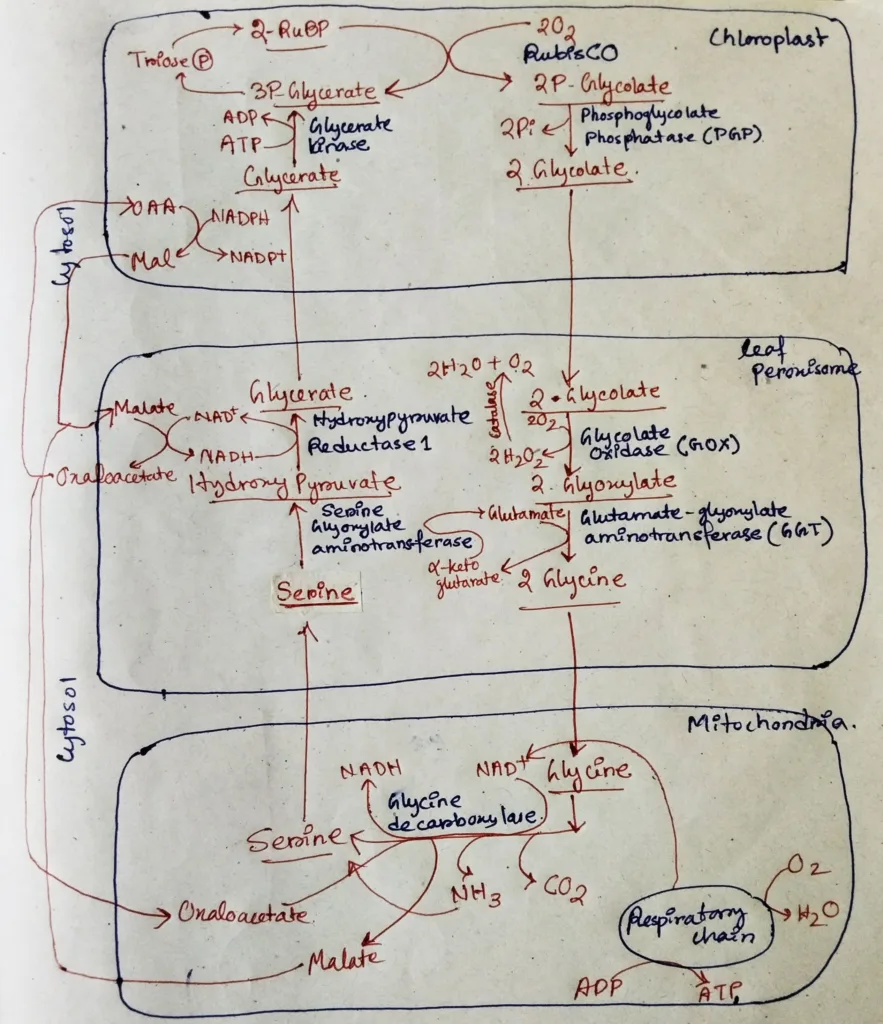
Significance of Photorespiration:
This process is a wasteful process because it reduces dry matter production and yield of the plant. it consumes energy and delays PGA production. However, this process is not entirely harmful as it is useful to the plants in the following ways:
- Glycine and serine, synthesized in the process are precursors of many important metabolites like proteins, chlorophyll, nucleotides, etc.
- PGA regeneration takes place at the end of the process.
- Glycolate formation protects against the destructive action of photooxidation.
- C2 cycle does not produce ATP, rather than it consumes energy.
- During the C2 cycle consume the ATP and NADH + H+.
- This process has no relation with respiration it takes place only in the photosynthetic cells only in the presence of the light.
- It happens only in C3 plants. C4 plants have overcome the photorespiration by evolving oxygen.
- During this process, 25% loss of fixed CO2 which is absorbed by the plants at the time of photosynthesis. Therefore, it is a wasteful method.
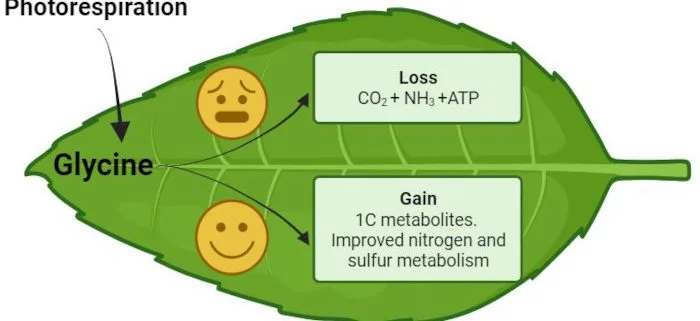
Other related notes:
- Photosynthesis equation: https://thebiologyislove.com/photosynthesis-equation-and-reactants/
- Light reaction: https://thebiologyislove.com/light-reaction-of-photosynthesis/
- Dark reaction (C3 cycle): https://thebiologyislove.com/calvin-benson-cycle-or-dark-reaction/
- C4 cycle: https://thebiologyislove.com/hatch-and-slack-pathway-c4-cycle/
- CAM: https://thebiologyislove.com/crassulacean-acid-metabolism-cam/
Facebook link: https://www.facebook.com/share/p/21uf64EYp1nPAhwT/?mibextid=oFDknk
Instagram link: https://www.instagram.com/p/C6OzDRTxpgK/?igsh=MWt6N2U1aXBuZG1scg==
